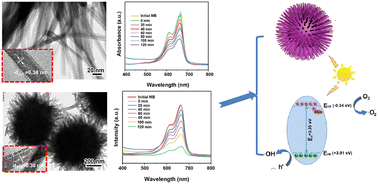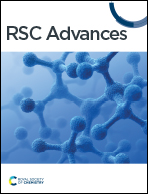Study on the photocatalytic properties differences between the 1-D and 3-D W18O49 particles†
Abstract
The morphology of W18O49 catalysts has a significant effect on their photocatalytic performance. Herein, we successfully prepared two commonly used W18O49 photocatalysts just by changing the reaction temperature in the hydrothermal system, namely 1-D W18O49 nanowires (1-D W18O49) and 3-D urchin-like W18O49 particles (3-D W18O49), and evaluated the difference of their photocatalytic performances by taking the degradation of methylene blue (MB) as an example. Remarkably, 3-D W18O49 exhibited an impressive photocatalytic degradation performance towards MB with photocatalytic reaction rates of 0.00932 min−1, which was about 3 times higher than that of 1-D W18O49. The comprehensive characterization and control experiments could further reveal that the hierarchical structure of 3-D W18O49 brought higher BET surface areas, stronger light harvesting, faster separation of photogenerated charges and so on, which was the main reason for its better photocatalytic performance. ESR results confirmed that the main active substances were superoxide radicals (˙O2−) and hydroxyl radicals (˙OH). This work aims to explore the intrinsic relationship between the morphology and photocatalytic properties of W18O49 catalysts, so as to provide a theoretical basis in the morphology selection of W18O49 or its composite materials in the field of photocatalysis.



 Please wait while we load your content...
Please wait while we load your content...